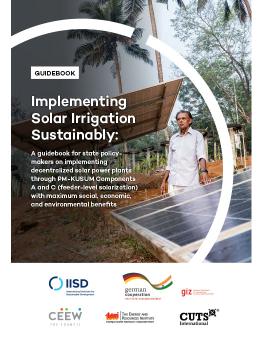
Implementing Solar Irrigation Sustainably
A guidebook for state policy-makers on implementing decentralized solar power plants through PM-KUSUM Components A and C (feeder-level solarization) with maximum social, economic, and environmental benefits
The Pradhan Mantri Kisan Urja Suraksha evam Utthaan Mahabhiyan (PM-KUSUM) scheme, launched in 2019 by the Ministry of New and Renewable Energy, aims to transform India's agriculture sector by improving crop productivity and increasing farm incomes through the solarization of the agriculture sector. This document forms the second part of a guidebook series, providing recommendations to state policy-makers on how they can implement solar irrigation models effectively and sustainably. This guidebook covers Component A and the subcomponent "Feeder-Level Solarization" under the Component C of PM-KUSUM. The previous guidebook addressed Component B and the subcomponent "Individual Pump Solarization" under Component C.
-
Solarizing agricultural feeders can benefit both farmers and power distribution companies.
-
Reducing risks associated with implementing and financing decentralized solar plants will be essential for its scale up.
-
States can use early deployments to study innovative approaches like agrivoltaics and direct benefit transfer incentives for farmers.
Solarizing irrigation has huge potential. Cost-effective and reliable irrigation can significantly improve farmer incomes and well-being. Shifting away from highly subsidized grid electricity can relieve financial pressure on electricity distribution companies—a review of tariff orders in 17 states and Union Territories found that 75% of all such subsidies go to agriculture. Furthermore, solar irrigation can help India shift to clean energy, reducing air pollution and greenhouse gas emissions. At the same time, care must be taken to implement it sustainably. There are complicated interconnections between water, energy, and food—often called the “water–energy–food nexus”—where interventions in one area can cause unexpected impacts in another.
This guidebook has been developed in cooperation with the Ministry of New and Renewable Energy. It is dedicated to supporting state policy-makers and agencies in sustainably implementing grid-connected solar power at a substation level, thereby “solarizing” the supply used by farmers connected to the substation. We refer to this as “decentralized solar power plants for irrigation,” which includes components A and C(FLS) of PM-KUSUM. Given the relative lack of experience with these models in India, we aim to bring together essential guidance on implementing them effectively. We also examine sustainability, identifying best practices for maximizing social outcomes and groundwater resources. Based on an initial needs assessment, this guidebook covers the following:
- Context: What are these models, and what are their potential impacts?
- Financing: What can states do to reduce the costs of financing?
- Implementation design and coordination: How can specific inter- and intra-departmental coordination mechanisms improve outcomes?
- Learning by doing: While states prioritize immediate deployment, how can they integrate pilots of innovative approaches for maximizing sustainability to inform ongoing improvements?
As a guidebook, this publication is based on the best available evidence, but it is not a research paper. We focus on practical suggestions for state policy-makers and implementing agencies with illustrative examples, drawing on a combination of secondary and primary research, including:
- Reviews of existing policy research literature
- 32 in-depth interviews with state and central officials, financiers, and policy experts
- Case studies on state schemes in Maharashtra and Punjab (see Appendix)
- A background paper on agrivoltaics based on literature review and stakeholder consultations (provided as a supplementary to this guidebook)
- Various multistakeholder round tables with policy-makers and experts on solar irrigation
This guidance is focused only on components related to decentralized solar power plants for irrigation. It is intended to directly assist state policy-makers with implementing PM-KUSUM and be relevant for any solar irrigation scheme, including future policies once PM-KUSUM is completed. For guidance on other forms of solar irrigation—stand-alone and grid-connected pumps—see our separate guidebook Implementing Solar Irrigation Sustainably: A Guidebook for State Policy-Makers on Maximizing the Social and Environmental Benefits From Solar Pump Schemes, published in 2021.
Supported by the Deutsche Gesellschaft für Internationale Zusammenarbeit (GIZ) GmbH and funded by the German Federal Ministry for Economic Cooperation and Development (BMZ).

You might also be interested in
India Faces Clean Energy Challenges as Energy Demand Soars and Global Fossil Fuel Subsidies Rise
New research finds the global energy crisis and increasing energy demand have pushed India's energy subsidies to a 9-year high.
Decentralized Solar Power Plants Can Be Win-Win Strategy For Farmers, Local Communities, State Governments And DISCOMs
The implementation of decentralized solar plants under the government’s Pradhan Mantri Kisan Urja Suraksha evam Utthan Mahabhiyan (PM-KUSUM) program can boost farmer incomes, help India reach 50% of non-fossil power capacity by 2030, and improve the financial viability of distribution companies (DISCOMs), according to a new report launched today.
States Must Define Standards to Overcome Challenges in Agrivoltaics: IISD
A recent report published by the International Institute for Sustainable Development (IISD) has listed specific business models that would help India cope with the challenges of implementing agrivoltaics.
Agrivoltaics In India : Simultaneous Use Of Land For Both Agriculture And RE Power Generation Offers A Potential Solution
Agrivoltaics — the simultaneous use of land for both agriculture and photovoltaic (PV) power generation — offers a potential solution to the competition for land resources between agriculture and renewable energy that may arise in the future in India.